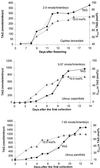Supply of fatty acid is one limiting factor in the accumulation of triacylglycerol in developing embryos
- PMID: 10444089
- PMCID: PMC59339
- DOI: 10.1104/pp.120.4.1057
Supply of fatty acid is one limiting factor in the accumulation of triacylglycerol in developing embryos
Abstract
The metabolic factors that determine oil yield in seeds are still not well understood. To begin to examine the limits on triacylglycerol (TAG) production, developing Cuphea lanceolata, Ulmus carpinifolia, and Ulmus parvifolia embryos were incubated with factors whose availability might limit oil accumulation. The addition of glycerol or sucrose did not significantly influence the rate of TAG synthesis. However, the rate of (14)C-TAG synthesis upon addition of 2.1 mM (14)C-decanoic acid (10:0) was approximately four times higher than the in vivo rate of TAG accumulation in C. lanceolata and two times higher than the in vivo rate in U. carpinifolia and U. parvifolia. In C. lanceolata embryos, the highest rate of (14)C-TAG synthesis (14.3 nmol h(-1) embryo(-1)) was achieved with the addition of 3.6 mM decanoic acid. (14)C-Decanoic acid was incorporated equally well in all three acyl positions of TAG. The results suggest that C. lanceolata, U. carpinifolia, and U. parvifolia embryos have sufficient acyltransferase activities and glycerol-3-phosphate levels to support rates of TAG synthesis in excess of those found in vivo. Consequently, the amount of TAG synthesized in these oilseeds may be in part determined by the amount of fatty acid produced in plastids.
Figures


Similar articles
-
Regulation of triacylglycerol biosynthesis in embryos and microsomal preparations from the developing seeds of Cuphea lanceolata.Biochem J. 1990 Nov 15;272(1):31-8. doi: 10.1042/bj2720031. Biochem J. 1990. PMID: 2264835 Free PMC article.
-
Two novel diacylglycerol acyltransferase genes from Xanthoceras sorbifolia are responsible for its seed oil content.Gene. 2013 Sep 15;527(1):266-74. doi: 10.1016/j.gene.2013.05.076. Epub 2013 Jun 11. Gene. 2013. PMID: 23769928
-
The role of acyl carrier protein isoforms from Cuphea lanceolata seeds in the de-novo biosynthesis of medium-chain fatty acids.Planta. 1998 Jun;205(2):263-8. doi: 10.1007/s004250050320. Planta. 1998. PMID: 9637071
-
Type 1 diacylglycerol acyltransferases of Brassica napus preferentially incorporate oleic acid into triacylglycerol.J Exp Bot. 2015 Oct;66(20):6497-506. doi: 10.1093/jxb/erv363. Epub 2015 Jul 20. J Exp Bot. 2015. PMID: 26195728 Free PMC article.
-
Advancing oleaginous microorganisms to produce lipid via metabolic engineering technology.Prog Lipid Res. 2013 Oct;52(4):395-408. doi: 10.1016/j.plipres.2013.05.002. Epub 2013 May 16. Prog Lipid Res. 2013. PMID: 23685199 Review.
Cited by
-
A role for diacylglycerol acyltransferase during leaf senescence.Plant Physiol. 2002 Aug;129(4):1616-26. doi: 10.1104/pp.003087. Plant Physiol. 2002. PMID: 12177474 Free PMC article.
-
Seed Transcriptomics Analysis in Camellia oleifera Uncovers Genes Associated with Oil Content and Fatty Acid Composition.Int J Mol Sci. 2018 Jan 2;19(1):118. doi: 10.3390/ijms19010118. Int J Mol Sci. 2018. PMID: 29301285 Free PMC article.
-
Metabolic control analysis is helpful for informed genetic manipulation of oilseed rape (Brassica napus) to increase seed oil content.J Exp Bot. 2008;59(13):3543-9. doi: 10.1093/jxb/ern206. Epub 2008 Aug 13. J Exp Bot. 2008. PMID: 18703491 Free PMC article.
-
In silico identification and comparative genomics of candidate genes involved in biosynthesis and accumulation of seed oil in plants.Comp Funct Genomics. 2012;2012:914843. doi: 10.1155/2012/914843. Epub 2012 Jan 24. Comp Funct Genomics. 2012. PMID: 22312320 Free PMC article.
-
An Improved Variant of Soybean Type 1 Diacylglycerol Acyltransferase Increases the Oil Content and Decreases the Soluble Carbohydrate Content of Soybeans.Plant Physiol. 2016 Jun;171(2):878-93. doi: 10.1104/pp.16.00315. Epub 2016 Apr 19. Plant Physiol. 2016. PMID: 27208257 Free PMC article.
References
-
- Bafor M, Stymne S. Substrate specificities of glycerol acylating enzymes from developing embryos of two Cuphea species. Phytochemistry. 1992;31:2973–2976.
-
- Bligh EG, Dyer WJ. A rapid method of total lipid extraction and purification. Can J Biochem Physiol. 1959;37:911–917. - PubMed
-
- Browse J, Somerville CR, Slack CR. Changes in lipid composition during protoplast isolation. Plant Sci. 1988;56:15–20.
LinkOut - more resources
Full Text Sources
Other Literature Sources

